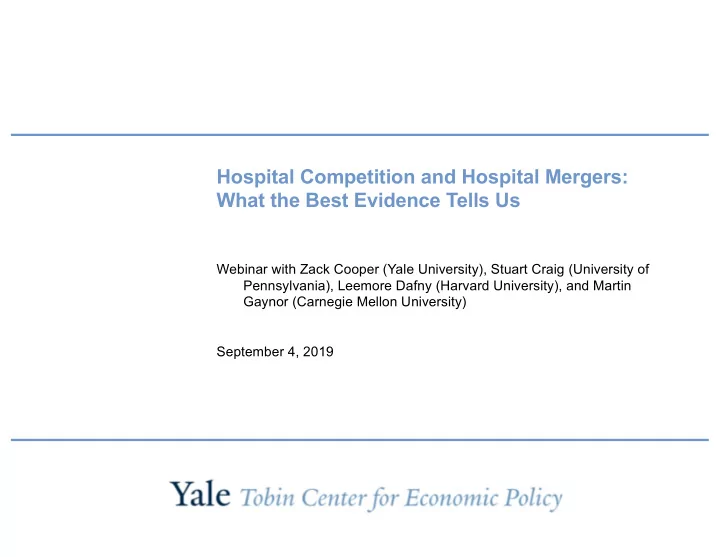

Hospital Competition and Hospital Mergers: What the Best Evidence Tells Us Webinar with Zack Cooper (Yale University), Stuart Craig (University of Pennsylvania), Leemore Dafny (Harvard University), and Martin Gaynor (Carnegie Mellon University) September 4, 2019
Introduction • The average premium for employer-sponsored family health coverage was $19,616 in 2018 [Kaiser Family Foundation, 2018 – Employer Health Benefits Survey] • Hospitals account for 33% of health spending (the largest individual category) [ 2018 National Health Expenditure Survey ] • The hospital sector accounts for 6% of gross domestic product [2018 National Health Expenditure Survey] • The hospital industry has undergone significant consolidation over the last 30 years 1
Hospital Mergers Per Year (Number of Transactions) 2
Commuting Zone HHIs in 2001, 2007, and 2014 2001 2007 2014 2001 Mean 2007 Mean 2014 Mean HHI 5,110 HHI 5,185 HHI 5,400 .0002 .00015 Density Estimate .0001 .00005 0 0 1,000 2,000 3,000 4,000 5,000 6,000 7,000 8,000 9,000 10,000 HHI Notes: The graph displays the kernel density estimate of the distribution of Commuting Zone-HHIs across the country. Each Commuting Zone’s HHI is a hospital bed-weighted average of the HHIs of the hospitals in that Commuting Zone. A hospital’s market includes all hospitals within a 45 minute travel time of said hospital. Each hospital’s share of the market is based on how many beds its health network controls in the hospital’s market. The density function is estimated using kdensity command in Stata. Source: Cooper 2019 3
Health Spending on the Commercially Insured Varies by a Factor of 3 Across the Nation Commercial Health Spending, 2015 Source: Cooper, Craig, Gaynor, and Van Reenen (2019). “The Price Ain’t Right? Hospital Prices and Health Spending on the Privately Insured”. Quarterly Journal of Economics, 134(1)): 51-107 4
Inpatient Prices Across Hospital Referral Regions 5
Source : Cooper, Craig, Gaynor, Harish, Krumholz, and Van Reenen (2019). “Hospital Prices Grew Substantially Faster than Physician Prices For Hospital-Based Care in 2007 – 2014”. Health Affairs, 38(2): 184-189 6
Hospital Concentration, Prices, and Contract Structure Hospital Concentration and Prices 14.0% 12.5% 12.0% 10.0% 7.6% 8.0% 6.0% 3.6% 4.0% 2.0% 0.0% Monopoly Duopoly Triopoly • Monopoly hospitals had a higher share of inpatient cases paid as a share of charges • Monopoly hospitals had fewer cases linked to the Medicare fee schedule Source: Cooper, Craig, Gaynor, and Van Reenen (2019). “The Price Ain’t Right? Hospital Prices and Health Spending on the Privately Insured”. Quarterly Journal of Economics, 134(1)): 51-107 7
There is Expansive Variation in Prices Within Hospitals Lower-Limb Prices at One High Volume Hospital Source: Cooper, Craig, Gaynor, and Van Reenen (2019). “The Price Ain’t Right? Hospital Prices and Health Spending on the Privately Insured”. Quarterly Journal of Economics, 134(1)): 51-107 8
Impact of Mergers on Prices Price Effect (%) • Inova Health System acquisition of Prince William Hospital – simulated price increase of 30.5% (Gowrisankaran, Nevo, and Town, AER, 2015). • Sutter’s prices increased between 28% and 44% following its merger with Alta-Bates (Tenn, 2011). Source: Cooper, Craig, Gaynor, and Van Reenen (2019). “The Price Ain’t Right? Hospital Prices and Health Spending on the Privately Insured”. Quarterly Journal of Economics, 134(1)): 51-107 9
Concluding Thoughts • The hospital sector is the largest contributor to health spending in the US • The industry has gone through substantial consolidation over the last twenty to thirty years • In the cross-section, concentration is linked to higher prices and more favorable contractual terms • Ex-post merger analysis shows that mergers can raise prices • At a point where we need to consider either price regulation or substantial increases in antitrust enforcement budgets. 10
Recommend
More recommend